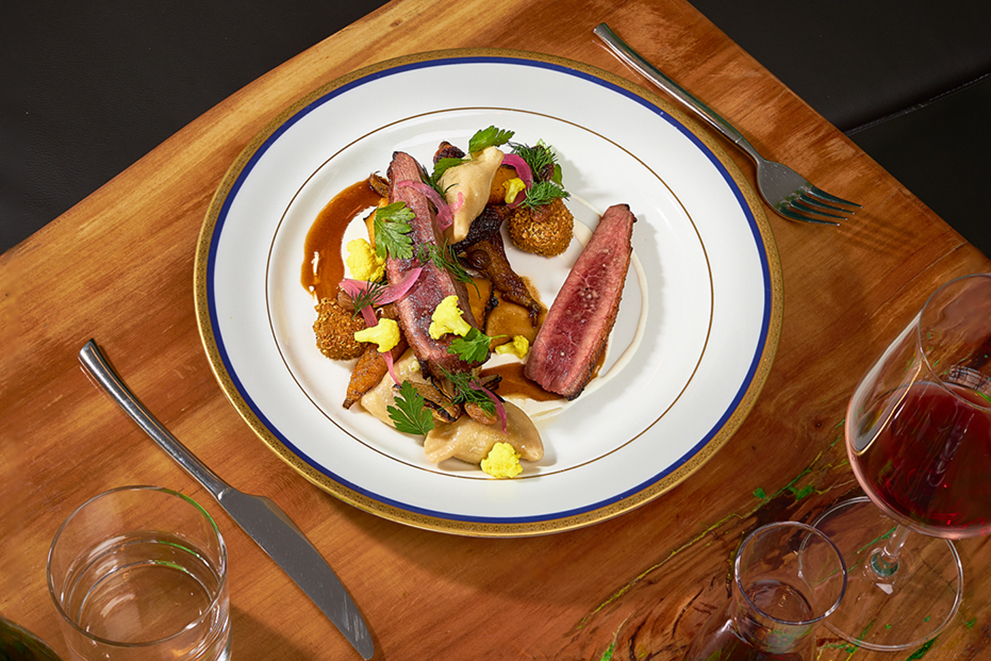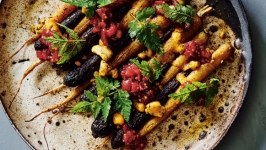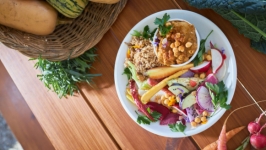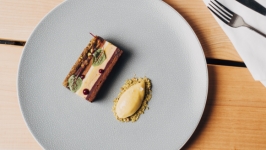Back at it at Brassica
When chef Arup Jana, owner and executive chef at Brassica, presented a plate of charcoal grilled duck breast served with duck confit pierogies, charred cabbage, onion jam, crème fraîche, haskap berry and roasted squash and carrots, it was hard to imagine how the Polish element on the plate represented him. And then he revealed it — he was born and raised in Saskatoon, where Eastern European culture is strong.
He seared and finished the duck in the oven to a perfect medium rare and punctuated it with bits of fresh dill to, as he puts it, “lighten it up.”
He scored the carrots give them additional texture and make them look even prettier — “I treated them the way you might treat the top of a duck breast” — and roasted them with the squash. He finished both with a small amount of duck fat, smashed garlic and thyme.
The dish also included shallots, pickled red onions and green onions. "We use a lot of onions in everything,” Jana says.
Then there were the confit onions, held together by their natural sugars and then formed into discs, breaded and fried.
The pierogies were made more elegant than their authentic brethren with a rich duck confit and cabbage filling.
The meat was inventive, as the restaurant promises in its Google promo, and vegetables were most definitely not an afterthought. After all, this restaurant is named after them. Brassica is a genus of plants in the cabbage and mustard families, including turnip, cauliflower and the like. And in addition to cabbage, this dish also includes small bits of pickled cauliflower and whole pickled raisins, both of which add pop to the flavour.
An early start
Jana did well in high school, but university was harder as he didn’t do well with independent study. In spite of having a father who was an academic, he didn’t complete his third year at university and meanwhile, he’d been falling in love with the culinary industry, having started to bus tables at the age of 16 at a West Coast chain called Bonanza, which he compares to Ponderosa. He soon decided cooking was his calling and was planning to enroll at the Cordon Bleu in Ottawa until the $30,000 price tag scared him off. Instead, he decided to sample culinary school by taking a professional cooking course at SIAST (now Saskatchewan Polytechnic).
The program had visiting chef nights and one night a chef from a nearby restaurant called Calories came by. Jana decided he wanted to cook with him at the “very classical French bistro” he ran with his wife.
He remembers the chef bringing in whole animals — sometimes as 10 fresh lambs — and teaching him how to butcher them.
“Then we got some kind of elk and he was as big as the whole walk-in freezer,” Jana recalls. “It was crazy, but I learned a lot about cutting meat and fish. And we’d always get everything local — all the chickens and pigs were local.”
Eventually, Jana did move to Ottawa, with his brother, who was in finishing up his medical school residency. When they arrived, Jana started working at Camelot Golf Course in Cumberland.
“I didn't know the city at all,” Jana says. “My sister lived in Montreal so we visited her all the time and I was really thinking Ottawa would be similar to that, but it was nothing like Montreal, and it was hard to find a job.”
He started applying for jobs in the market and eventually got some shifts at Ei8hteen and Social and then discovered the sous-chef at Ei8hteen was taking over an Italian place on Beechwood Avenue called Baco.
“I had never done Italian so I thought I would learn something there,” he says. Soon after the head chef left, Jana was offered the job. “The funny thing is, we weren't like making any pasta or anything like that; it was all dried pasta and frozen ravioli and that kind of stuff,” he says. “But that was like most Italian places in Ottawa at the time, or the ones I had seen anyway.”
He did learn about costing for restaurants through that job and about time-management and, eventually, he taught himself how to make pasta, which shows up in the pierogies he prepared for edible Ottawa. And, he learned that managing people is “really, really difficult.”
It was the grounding he needed to open his own place so when a spot on Holland between Scott and Wellington Streets became available, he drew from some savings and rallied a few investors and bought it. He bought the building in 2004, just as the neighbourhood was on the cusp of a renaissance. Allium’s inventive menus were enough to bring even the most stalwart downtowners west and it also became a welcome local fine dining restaurant in a part of town that was then overrun with pubs.
“[The building] was cheap at the time because it really was Mechanicsville,” he says. “They had planned to build like the GCTC building, so it was definitely on its way, but that took a lot longer than it was supposed to.”
Allium attracted some lunch business from the federal employees at Tunney’s Pasture, but people only stuck around for 45 minutes most days with the exception of Fridays.
“We would sometimes have great [lunches] on Fridays because no one would go back to work after lunch,” he says.
Still, it was a rough start and the restaurant didn’t start making money until year four or five.
Then there were some good years, even though they often required Jana to be in the kitchen 80 hours a week. Fridays and Saturdays were always busy and his idea for small-plates Mondays was a runaway success on a weeknight when restaurants are often dead. But then disaster struck when a fire destroyed the restaurant in 2019 and his team — now akin to the dream team he needed to stop having to work so many hours — had to disperse in search of other jobs.
A series of unfortunate events
Jana came to be owner of Brassica as he was in the process of rebuilding Allium. He knew it would be a long rebuild, so while he was overseeing that, he first went to work at The Third, a neighbourhood pub on Wellington street that allowed him to make some money away from the pressures of running his own place and the demands of a fine-dining menu and clientele.
“I kind of wanted something low stress,” he says. During that time, he was approached by the folks who run Vittoria Trattoria, which had locations on Riverside Drive, Westboro and the ByWard Market. The market location was also destroyed in a fire so the would-be partners understood Jana’s pain. The Westboro location, meanwhile, didn’t seem to be wowing customers in the neighbourhood, so they were looking to do something different with it. Jana’s wine representative knew that and introduced the Vittoria folks to Jana and his wife Maggie Von Zur-Muehlen.
“We went for coffee and they said they just wanted us to take it over and do whatever we wanted with it while becoming 50-50 partners,” Jana says.
The Vittoria Trattoria operation closed on a Sunday in January 2020 and by the following Thursday, the restaurant was relaunched as Brassica, with Jana’s old team from Allium back in the kitchen and Von Zur-Muehlen and some of her former team running front of house.
“It was craziness, but we said ‘Let's do it,’” he says, adding that they hardly made any design changes before opening as Brassica. Since then, however, they’ve turned the red, grey and black colour scheme into a green and white one and altered some shelving.
“We were always on the fence about what to do here,” he says. “Because it was only supposed to be for two years. The lease was up after two years, but we have re-signed since then because it’s gone well.”
A global pandemic
In hindsight, taking over Brassica was a good move, but it sure didn’t feel like it in March 2020, just seven weeks after it opened, when the government ordered it to shut down. Jana had no choice but to start doing takeout immediately.
“We put things in boxes for two years,” Jana says. “I had never done takeout before and I didn't ever want to. Doing it exclusively — that was really hard.”
Jana remembers cutting his finger on the very first container he was filling — they were foil containers and it was a deep cut. “I just remember wrapping up my fingers and taping them,” he says.
He spent that first month working alone in the kitchen, with Von Zur-Muehlen helping out front, and then the demand for Brassica’s style of takeout built enough that Jana could start bringing his cooks back. Von Zur-Muehlen who had worked in the restaurant industry for years, including at Allium and North & Navy, ended up getting a job in government during the pandemic, but she still works evenings in the front of house at Brassica.
“The goal is for her not to have to spend too much time here, but it's a rough industry at the moment,” Jana says, of the labour shortage, among other factors created by the pandemic. “And the fi re set us back a little.”
Inspirations and influences
The chef at Calories is someone Jana considers a big influence and he also names The Food Network, which was kicking off at the start of his fine dining career.
“I was just soaking it all in,” he says.
He says he still loves whole-animal cooking and he also likes what the chefs at Le Poisson Bleu on Somerset Street are doing by serving whole fish and curing fish.
He says when he and Von Zur-Muehlen travel, they always go to a Michelin-Star restaurant and it’s always enjoyable, but he says the advent of the YouTube instructional video is taking a bit of the mystery out of Michelin-Star techniques.
Meanwhile, when he’s putting together a menu, he thinks first about what’s available locally and then he builds around that.
“That really dictates what goes on the menu,” he says. He always aims for colour and texture, especially a crispy element.
“It’s just balance — balance and making sure people don’t feel really heavy at the end of it. But some people really like big portions. Our steak is 12 ounces,” he says with a laugh.
After many setbacks, he’s a man who still loves to please his diners and doesn’t take life too seriously.
Brassica
309 Richmond Road, Ottawa,
brassicaottawa.com | 613.680.7575 | @brassica_ottawa

















